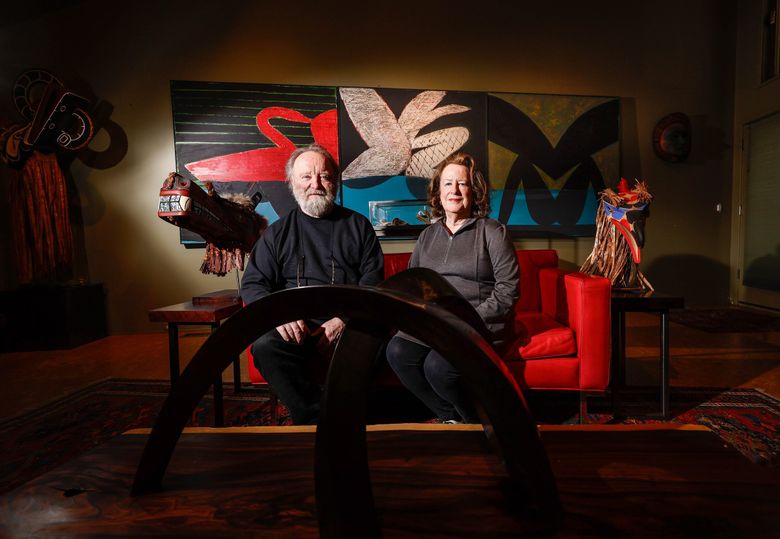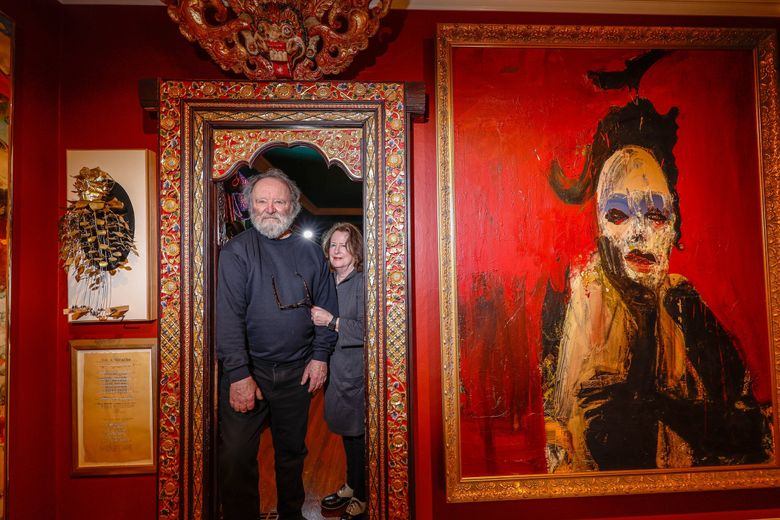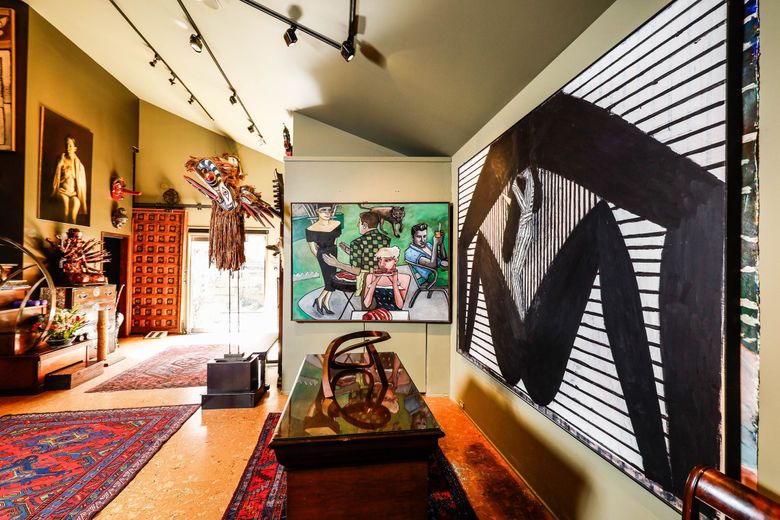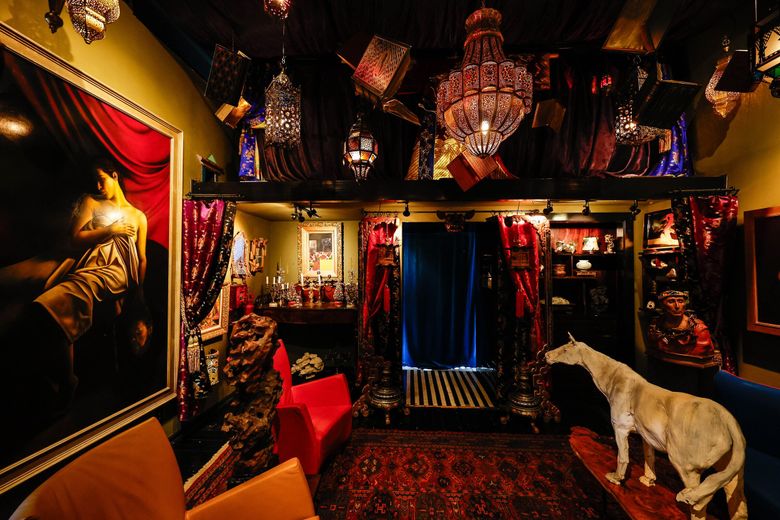
At first, you might not even notice the rectangular aluminum sign welcoming you to Utopian Heights.
Tacked partway up a telephone pole on a corner in Ravenna, the green-and-white beacon marks the house of artists Dennis Evans and Nancy Mee, who have lived in the neighborhood for over 50 years. Known for their prolific output — Evans is an installation artist, sculptor and painter; Mee is a sculptor and glass artist — the husband-and-wife creatives announced last year that they will be leaving their art collection — more than 250 pieces — to Seattle University.
The duo might be planning for after they pass, but each spouse is still very much involved in the art world: In June, Evans has an exhibition of his work at the Hallie Ford Museum of Art in Salem, Ore., and Mee’s artwork will be the subject of a book, “Femina Lucida, the Art of Nancy Mee,” written by Matthew Kangas, this fall. In October, the couple will have a joint exhibition at the Bainbridge Island Museum of Art titled, “Nancy Mee and Dennis Evans: Fifty Years.”
The Dennis Evans and Nancy Mee Collection Gift & Endowment includes around 180 pieces of contemporary Northwest art, with 85 different artists represented, including Alden Mason, Steve Jensen, Guy Anderson, Joseph Goldberg, Gene Gentry McMahon, Julie Speidel, Michael Spafford and Mary Ann Peters. The gift also includes funds to provide for the care of the art and the endowment of a chair in the art history department dedicated to teaching the history of Northwest art. The couple declined to disclose monetary values for the art and gifts.
“We have no children, and we have all of this art,” said Evans, who, at 78, can easily pull up names, dates and memories from decades ago with astonishing clarity and detail. “Given that we really cared about the collection, especially the artists, it was important that the pieces stay together. We’ve been collected by museums, and we find they often show the work, make a big splash, then put it away, sometimes for years.”
Recently, Evans and Mee opened their home to us. Stepping into Utopian Heights — the name that Evans and Mee bestowed on their house and studios (they own three buildings on the block, the first of which was purchased via auction in 1975 from the U.S. Department of Housing and Urban Development) — is like entering a living museum.

What was once a two-bedroom, one-bathroom workman’s bungalow has been expanded through the years (much of the work done by Evans and Mee) into a large, light-filled dining room, an entry atrium with soaring ceilings, elevated library, two studios, a lounge — all layered with art. Aside from work by Northwest artists, Evans and Mee have an extensive collection of Indigenous masks from around the world (“All purchased from contemporary artists,” Evans says, noting that they are aware of the provenance of each one), gongshi — Chinese scholar’s rocks, Chinese archaic jades and works by young Northwest artists, including a large assortment of kinetic sculptures by Casey Curran.
A riot of color and texture, Evans and Mee’s residence is a treasure trove of art — paintings on the walls, masks and sculptures, antique wooden doors from India and tile installations. It feels like a never-ending labyrinth of discovery; ducking into each room reveals something exciting, with pieces juxtaposed against each other, such as a swirling bronze sculpture by Gerard Tsutakawa placed near work by Ann Hamilton made from deconstructed books. The materials are vastly different, but the sensual curves in each are complementary.
“About a third of our art collection is out at all times,” Mee said, noting that they store the rest off-site. “When a new piece comes in, then we move things around. I love finding the dialogues that the works have with each other.”

For Evans and Mee, their relationship with much of their collection goes beyond that of mere consumers or art appreciators — they have known many of the artists for decades.
“We felt a real allegiance to our artists,” said Mee, who met Evans at the University of Washington, where they both went after the same assistant teaching position. Evans secured the spot, and Mee was salty about it — until the two started dating. “We wanted to give them a showcase, and part of our agreement with Seattle University is that the work will be hung throughout the campus and be on view for a long time.”
Part of this allegiance comes from the fact that a majority of the artists in Evans and Mee’s collections are colleagues, mentors, professors and friends that the two met and worked with in the ’70s, ’80s and ’90s after they both graduated from the University of Washington, where Evans earned a Master of Fine Arts in design and a Bachelor of Fine Arts in ceramics and Mee graduated with a Bachelor of Fine Arts in printmaking. (Evans also has a Bachelor of Science in chemistry — he started his academic career with ambitions of becoming a doctor, but after being drafted and spending two years in the Marine Corps, he pivoted to art.)
“All of the people we were in grad school with at UW, many still practice,” Evans said. “That mid-to-late-’70s group getting their MFAs — many stayed in Seattle after graduating and became professional artists rather than going off and getting teaching jobs like the generation before them. Mostly because there were no teaching jobs.”

This concentration of creativity was fertile ground for a thriving art scene where participants traded work, partook in Pioneer Square’s monthly art walk, and hopped around the city from studio to studio. Evans and Mee’s collection is a comprehensive snapshot of that particular time in Seattle’s visual arts scene.
Despite both Evans and Mee attending the University of Washington, it was a personal relationship with Seattle University that kicked off talks about the bequest. Born in Yakima, Evans attended a Jesuit high school and then spent his first year in college at Seattle University. Several years ago, the Rev. Josef Venker, curator of Seattle University’s permanent art collection, contacted him about commissioning a work for the school’s new Sinegal Center. While touring the campus, Evans was impressed with the institution’s commitment to displaying art — and actively using it in its curriculum.
“This gift means a great deal to Seattle University,” said Edgar S. Gonzalez, vice president of university advancement. “We are honored to be the stewards and caretakers of this art. Part of the Jesuit tradition is an education connected to art. We plan to display it throughout campus so that the students get to live with it every day.”
In March, Seattle University made national headlines when it received a gift from local philanthropist Richard Hedreen: his renowned art collection, valued at $300 million, and $25 million in seed funding to develop the Seattle University Museum of Art. At the time of the announcement, Evans and Mee had already committed their gift, and Evans said they were “not aware of the new museum or the other collection.”
Not that the knowledge would have changed their minds: Both artists see their bequest as complementary to the Hedreen gift. Evans and Mee have a deep, enduring passion for the region and hope to continue the legacy of some of its great artists. “The direction so many of our institutions are taking isn’t necessarily Northwest-centric,” Mee says. “With our gift, we hope to make artists of this region a prominent focus at Seattle University.”
"artist" - Google News
April 11, 2024 at 08:00PM
https://ift.tt/c4zKpFv
Artist couple donating collection to Seattle U basically live in a museum - The Seattle Times
"artist" - Google News
https://ift.tt/JfLmcS1
Bagikan Berita Ini














The opinions expressed in reader comments are those of the author only and do not reflect the opinions of The Seattle Times.